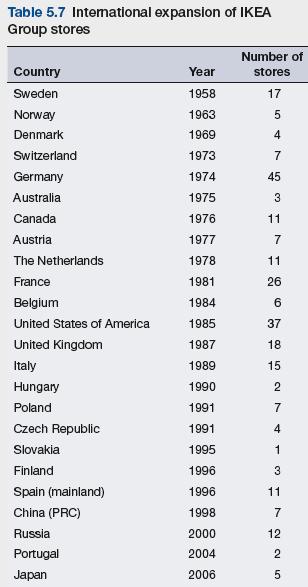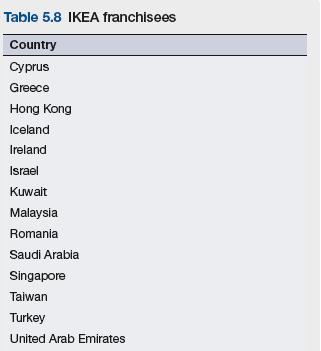In 1943 a 17-year-old Swedish boy started what was to become a multibillion euro company by selling
Question:
In 1943 a 17-year-old Swedish boy started what was to become a multibillion euro company by selling work pants and other farm supplies door-to-door. Ingvar Kamprad began selling farm implements under the name IKEA, which is an acronym for his name and where he was born. Today Inter IKEA Systems BV is the owner and franchiser of the IKEA concept. IKEA retailers worldwide operate on a franchise basis. As of 2015 there were a total of 318 stores across the world, not including around 40 franchised stores. IKEA Group activities are coordinated by INGKA Holding BV, which is the parent company for all IKEA Group companies and is owned by a charitable foundation in the Netherlands. IKEA of Sweden AB is responsible for the entire product range on behalf of Inter IKEA Systems BV. In the year 2009 the company had a turnover (sales volume) of euro 22.7 billion. IKEA is the world’s largest furniture and home furnishing retailer as of March, 2010 (www.IKEA.com, accessed March 3, 2010).
Company history
Well into the 1950s Sweden was a fairly poor country that was still struggling through sharp class differences. Kamprad, who grew up poor during that period, was struck by the notion that beautiful things should not be limited solely to the well-to-do, but should be available to everyone. With that appropriately egalitarian sentiment in mind, in 1950 he decided to add a line of well-designed, functional home furnishings to his list of farm products. They were an immediate hit. To expand the territory he could cover, Kamprad soon added a catalog, and then a showroom. By 1955, as Scandinavian-designed furniture was beginning to enjoy a worldwide reputation, IKEA began designing its own furnishings. The first IKEA retail store opened in 1958 in Almhult, a village not far from Kamprad’s boyhood home. By 1965, when IKEA opened its first store in Stockholm, a 450,000 square foot behemoth, thousands queued for a chance to sample the wares.
While those in the Scandinavian design community embraced Kamprad’s ideals of furniture that is aesthetically meaningful and available to a wide, non-elite market, it was not until the postwar period that its members began turning out the designs that would win such prestigious international competitions as the Milan Triennale. The international acclaim led the Scandinavian countries to market their home furnishings seriously to the world at large. By this time furniture and household decorative arts that used simple, unadorned, geometric forms had become known as Scandinavian design.
Company operations: tactics and strategy
The problem with Scandinavian design, however, was that it was still too expensive for the average consumer. As a result, several attempts to market Scandinavian furnishings beyond Sweden’s borders all failed. Bonniers, a Swedish chain, and Design Research in the United States both came and went in the 1960s and 1970s. But Kamprad, convinced that there was a broad, as yet unserved middle class that would want this beautiful furniture if it was reasonably priced, set out to cut his costs to the bone. In 1997 a line of children’s furniture and toys was added.
Price had been the key competitive idea behind IKEA since its inception, but to drive prices still lower Kamprad turned the ready-to-assemble (RTA) concept into an art form by manufacturing parts that can be easily put together. Even today most IKEA furniture can be assembled with only one tool, an Allen wrench, which is generally included as part of the kit.
The RTA proposition also saves money for IKEA on shipping and storage. Most of the company’s products are packed in flat boxes, reducing transportation costs, minimizing the risk of damage, and making them easy for the customer to take home. IKEA’s RTA approach works, says Jan Kjellman, president of IKEA North America, because consumers realize that ‘by doing half the job they will pay so much less than they would at a traditional furniture store.’
Thus IKEA recognized that the value added in making furniture was not necessarily in manufacturing. IKEA designed kits that put the consumer in the middle of the value chain, giving them lots of things to do that were traditionally done by the manufacturer. This took incredible amounts of cost out of its system.
IKEA further reduced its costs by becoming production oriented. The company strives to carry out product development on the shop floor. It sends its ten in-house designers into its suppliers’ factories to learn the capabilities and limitations of their machinery so that product designs can be adapted to the machines, instead of the other way around. ‘Most designers look at the form and the function, but ours must also look at the price,’ explains Kjellman. ‘We don’t want to make limited edition products. We want to mass produce them.’
Sometimes keeping costs down means that an IKEA design will be made of a lesser-quality material. For example, the company does not hesitate to make a painted tabletop out of a lower grade of wood, or substitute a simpler material for a base that is not seen. And furniture that would be too expensive to make in birch is made out of pine.
While the company aims to provide a good quality product, price is still the main reason that people shop at IKEA. Its furniture, toys, and housewares typically are priced 20% to 30% below competitors.
International expansion
International expansion started in the 1960s when the company was forced to source products outside Sweden. Local Swedish furniture retailers felt that IKEA’s low-price policy was unfair competition and they tried to prevent local manufacturers from supplying them with goods.
Rather than raise prices, IKEA sourced their own designed goods outside Sweden. Today the company sources its products from 1,800 suppliers in more than 50 countries and contracts for capacity rather than a set number of items from its manufacturers. In some instances IKEA has taken ownership positions in factories that supply it with furniture and household goods. In other cases it acts as a financier, especially in eastern Europe. IKEA also operates 28 distribution centers worldwide.
It took IKEA 30 years to grow beyond its boundaries as a local, seven-store chain and penetrate foreign markets.
When it was time to expand, explains Kjellman, ‘We decided to go to the most conservative market we could find and that was Switzerland.’ With success there, IKEA began a slow, steady expansion that has gradually taken it into northern Europe, especially Germany, central Europe, Australia, and Canada. The market expansion history indicating when the first store was opened in a foreign country and the number of stores in operation as of March, 2010 are shown in Table 5.7. In addition to stores owned by the IKEA Group, there are stores owned by franchisees in 14 other countries/territories as shown in Table 5.8.
During the 1980s IKEA was opening between five and ten stores a year. But expansion slowed considerably in the 1990s as the company consolidated its holdings and worked on increasing per-store sales and raising overall profitability.
Worldwide expansion has brought new challenges, among them the need to gauge demand and then stock accordingly. ‘We have had a lot of shortages,’ acknowledged Kjellman. ‘One of the biggest problems we have faced as we have moved out of Sweden was having enough of the right product in the stores. We underestimated how much we would sell when we first entered the North American market.’
The US market
An even bigger problem that IKEA has had to overcome is its limited name recognition. ‘The first thing we did when we entered the United States was to teach people how to pronounce our name,’ Kjellman says. To do so, IKEA ran

ads featuring an eye, a key, and a plus sign followed by the word ‘ah.’ After this initial campaign the company began advertising its value proposition of well-designed home furnishing at affordable prices in ads that featured the tag line: ‘It’s a big country. Someone’s got to furnish it.’ In 1990 IKEA expanded by acquiring five stores owned by Stor Furnishings International in California.
During the period 1985–2002, sales in the United States grew from US$50 million for one store to US$1.3 billion for 17 stores. Its first profit was not earned until 1993. A major reason for this growth is that US consumers view low prices as a given.
Realizing that the United States is a highly mobile society with a large rate of household formation and change,

IKEA has changed its television advertising to link the value of its home furnishings to easy, affordable lifestyle choices. Kjellman understands that he is not just competing with other furniture chains, but with anyone vying for disposable income. ‘We have to convince people that they should come to us to buy a new sofa,’ he says. While establishing its presence in the United States has not been easy, the company has no intention of leaving.
The US furniture market is enormous and highly fragmented. ‘The United States is the toughest market in the world, but we can learn a lot from it,’ says Kjellman. The furniture trends that begin in the United States, such as home entertainment units or home office furnishings, gradually work their way to other parts of the world. By being where those trends are starting, IKEA can develop new designs to meet those trends and then amortize its costs by selling them into other parts of the world.
IKEA’s appeal is that its furniture is accessible, approachable, and economical. ‘We have met a need that nobody bothered about,’ Kamprad says. ‘And the response has been fantastic.’
Questions
1. Evaluate the market expansion approach taken by IKEA.
2. Is it better for IKEA to own its factories or to contract for its products?
Step by Step Answer:

International Marketing And Export Management
ISBN: 9781292016924
8th Edition
Authors: Gerald Albaum , Alexander Josiassen , Edwin Duerr





